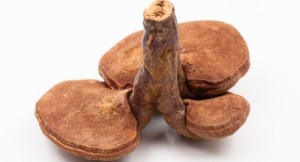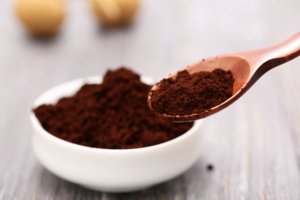Ganoderma lucidum(also called G. lucidum, reishi, lingzhi) has numerous different biologically active constituents, the main ones include various triterpenes, polysaccharides, and proteins. The pharmacologically active compounds are present in different amounts in various parts of G. lucidum such as the fruiting bodies, mycelium, and spores.
Triterpenes
 Terpenes are a large and diverse group of naturally occurring compounds derived from the branched C5 carbon skeleton of isoprene. Triterpenes are a subclass of terpenes and are derived from squalene, a C30 hydrocarbon. They can be classified based on the number of cyclic structures making up the compounds. More than 150 triterpenes have been identified from the spores, fruiting bodies, and mycelia of ganoderma lucidum. The methods of extraction of triterpenes usually involve methanol, ethanol, chloroform, ether, or acetone. These extracts can be further purified by various separation methods such as normal and reverse-phase high-performance liquid chromatography (HPLC). The majority of triterpenes identified are ganoderic acids and lucidenic acids; other important triterpenes include ganodermic acids, ganoderals, and ganoderiols. The strong bitterness of ganoderma lucidum originates from the triterpenoid compounds and the bitterness depends on the strain, cultivation conditions, and manufacturing processes. Triterpenoids have been shown to exhibit various biological activities including anti-hypertensive, lipid-lowering, anti-acetylcholinesterase, antioxidant, and anticancer activities, etc.
Terpenes are a large and diverse group of naturally occurring compounds derived from the branched C5 carbon skeleton of isoprene. Triterpenes are a subclass of terpenes and are derived from squalene, a C30 hydrocarbon. They can be classified based on the number of cyclic structures making up the compounds. More than 150 triterpenes have been identified from the spores, fruiting bodies, and mycelia of ganoderma lucidum. The methods of extraction of triterpenes usually involve methanol, ethanol, chloroform, ether, or acetone. These extracts can be further purified by various separation methods such as normal and reverse-phase high-performance liquid chromatography (HPLC). The majority of triterpenes identified are ganoderic acids and lucidenic acids; other important triterpenes include ganodermic acids, ganoderals, and ganoderiols. The strong bitterness of ganoderma lucidum originates from the triterpenoid compounds and the bitterness depends on the strain, cultivation conditions, and manufacturing processes. Triterpenoids have been shown to exhibit various biological activities including anti-hypertensive, lipid-lowering, anti-acetylcholinesterase, antioxidant, and anticancer activities, etc.
Polysaccharides and peptidoglycans
Ganoderma lucidum polysaccharides are macromolecules with a molecular mass of above 500kDa. Many different polysaccharides, including (1→3), (1→6)-α/β-glucans, α-d-glucans, α-d-mannans, and polysaccharide-protein complexes, have been identified from the spores, fruiting bodies, and mycelia of ganoderma lucidum. These compounds are proved to have immunomodulatory and anticancer activities. Glucose, together with xylose, mannose, galactose, and fucose in different conformations, forms the major component of the polysaccharide molecules. Polysaccharides are the major component by weight among all constituents in the spores. Several of the mushroom polysaccharide compounds have proceeded through Phase I, II, and III clinical trials and have been used in some Asian countries to treat various cancers and other diseases. The contents of polysaccharides differ among commercial Lingzhi products. Various bioactive peptidoglycans possess antiviral and immunomodulating activities, such as ganoderans A, B, and C, which have also been isolated from ganoderma lucidum.
activities. Glucose, together with xylose, mannose, galactose, and fucose in different conformations, forms the major component of the polysaccharide molecules. Polysaccharides are the major component by weight among all constituents in the spores. Several of the mushroom polysaccharide compounds have proceeded through Phase I, II, and III clinical trials and have been used in some Asian countries to treat various cancers and other diseases. The contents of polysaccharides differ among commercial Lingzhi products. Various bioactive peptidoglycans possess antiviral and immunomodulating activities, such as ganoderans A, B, and C, which have also been isolated from ganoderma lucidum.
Bioactive proteins
Several bioactive proteins from ganoderma lucidum have been reported. One of these is a polypeptide called Lingzhi-8 (LZ-8) which consists of 110 amino acids with a molecular mass of 12kDa. It has an immunoglobulin-like structure and was the first immunomodulatory protein isolated from reishi. Another protein from the fruiting bodies of ganoderma lucidum is ganodermin, which has a molecular mass of 15kDa and has antifungal activity.

Leave A Comment